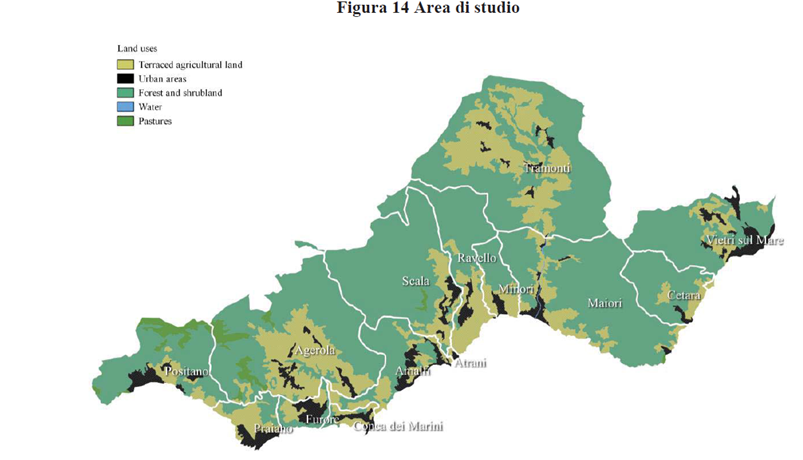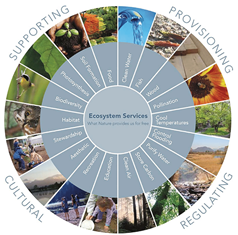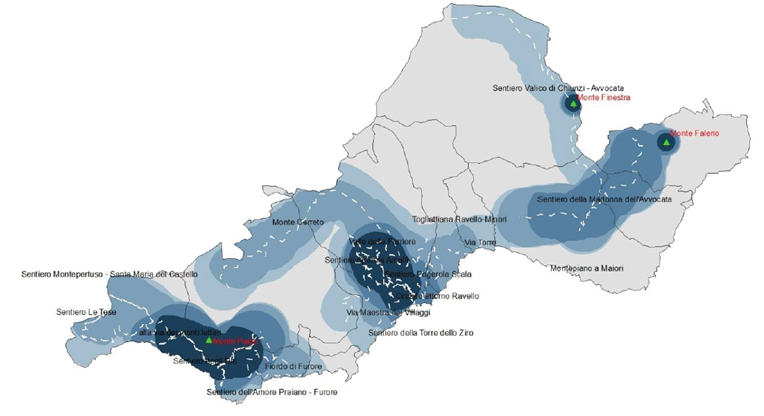In this year between lockdown and economic and social challenges, we take this opportunity to re-investigate the character of our territory. Terraces are manyfold – beautiful, cultivated, visited, maintainance intensive. But how to measure whether this is in balance? Here we investigate the question on how to measure the value of a terrace as a cultural, social, economic and natural heritage: “The valuation of cultural landscapes” – investigated by Antonia Gravagnuolo in her thesis at the University of Naples, Federico I, 2015, and it treats highly relevant aspects for everyone living or visiting the Amalfi Coast.
A. Gravagnuolo, “The valuation of cultural landscapes. Approaches and tools for the protection and enhancement of terraced systems.” University of Naples, Frederico II. 2015
In this research, presenting also a PhD thesis, the author A.Gravagnuolo talks about the valuation and the mapping of the terraces in the Amalfi Coast (figure 1) and points out the importance of conserving such landscapes.
What is “a terrace”?
Terraces are agricultural systems in mountain areas using dry-stone walls or slope cover with vegetation to maintain the soil. Terraces reduces the run-off of the water and the soil erosion. In that way, soil are fertile and have a good capacity to keep the soil humid. It also provides habitats for plant and animals species.
Terraces are a primordial part of the Amalfi Coast landscape. Its ecological, social and economic values contribute to the recognition by the UNESCO as a World Heritage site.

Figure 1: Study Area Amalfi Coast (Gravagnuolo, 2015).
Thanks to the beauty of its landscapes and the recognition by the UNESCO, the Amalfi Coast became a famous touristic site but the mass tourism is a threat which need to be regulated. Indeed, mass tourism means pollution, traffic jams, degradation of natural resources and a concentration of tourist on only few cities. Higher incomes from the tourism sector than incomes from agriculture in the terraces lead progressively toward the land abandonment. This is the main cause of the deterioration of the terraces which means cultural, social and economic losses.
To avoid this situation, public policies need to focus on the preservation of the agricultural activities (financial support for farmers, restoration, communication or sensibilization…). Acting on the preservation means acting on the welfare of the Amalfi Coast and its inhabitants. In order to create political weight, a lot of studies put in evidence the monetary importance of environmental sites.
That is why A. Gravagnuolo’s results contributes to the conservation of the terraces of the Amalfi Coast and by extension contributes to the wide effort of landscape preservation in the world. It is also part of the process of the candidature to the MAB program of UNESCO. This program promotes the link between human and nature, the MAB sites experiment sustainable projects.
Ecosystem services – What does an ecosystem “for us”?
Concretely, A. Gravagnuolo’s thesis aims to evaluate economically the terraces of the Amalfi Coast by different tools. First of all, services provided by the nature are free, everyone can take a walk in a forest and can breath fresh air or can fish for instance. Free access leads to overexploitation of natural resources. As the nature is not valued directly by any markets, and because scientists are still debating about quantify and qualify nature’s services, it is difficult to put monetary values on it. Neoclassical economy developed methods by introducing the notion of ecosystem services. Here are some definitions to understand better the thesis:
“An ecosystem is a dynamic complex of plant, animal, and microorganism communities and the non-living environment, interacting as a functional unit. Humans are an integral part of ecosystems.” Millennium Ecosystem Assessment (MEA)
“Ecosystem services are the benefits people obtain from ecosystems. These include provisioning services such as food and water; regulating services such as flood and disease control; cultural services such as spiritual, recreational, and cultural benefits; and supporting services, such as nutrient cycling, that maintain the conditions for life on Earth.” Millennium Ecosystem Assessment (MEA)

Figure 2: Classification of ecosystem services from the Millennium Ecosystem Assessment. Metro Vancouver
The scientific and international report Millennium Ecosystem Assessment (MEA) popularized in the 2000’s and classified those services in four categories (figure 2): Supporting; Regulating; Provisioning; Cultural. It is important to underline the interdependence of each service. If one ecosystem doesn’t provide anymore (or provides in less quantity) one of its services, other ecosystems are impacted and their services as well.
Results – estimating a “value”
Monetary valuation allows to quantify the ecosystem services. Many methods of monetary valuation are used among scientific studies around the world; amongst those direct market prices of terraces, costs that would occur in case of a replacement, or costs that people are willing to pay in order to benefit from the terraced landscapes (such as tourism costs) (TEEB, 2011).
In her results, A. Gravagnuolo diffused two questionnaires on social networks for residents and tourists of the Amalfi Coast. Local association such as ACARBIO helped to get answers. The first one includes 3 parts: priority of the ecosystem services, mapping information, amount of money the person interrogated is willing to pay for the preservation of the terraced landscape. With those data, market informations and maps, ecosystem services have been evaluated in a qualitative and a quantitative way.

Figure 4: Map of the recreating and touristic use in the Amalfi Coast. Gravagnuolo, 2015.
Thanks to the data from the questionnaire and the analysis of the market, specific maps have been realized to prioritize the effort of conservation. Figure 4 is an example of a map representing the cultural service “Recreating and touristic use of the landscape” classified in five categories of colours depending the density of recreating/touristic sites in the Amalfi Coast. The darker blue is associated to the high density of recreating and touristic sites. Therefore, considering the available information and the order of priority, the monetary valuation of the thesis focuses on the following key services: hydro-geologic stability, conservation of the knowledge patrimony and cultural identity; agricultural biodiversity; food production.
Applying different methods, the estimation of the value for “a terrace” arrives at different levels – they go from around 1.300 according (costs of conserving patrimony of knowledge and cultural identity) to 130.000 Eur/ha a year. Confronting this in a costs and benefits analysis, it shows that the social benefits can cover the costs of maintainance of the terraces. This could, according to the conclusions of the study, be covered through different ways, i.e. a fee of entry for the tourists and a tax for the residents of the Amalfi Coast.
What can we take from this?
Every contingent valuation contains bias, indeed, the amount of money that people are willing to pay can be overestimated. It is an estimation as for the others values of ecosystem services. The values above are not exact numbers or prices of the services and they cannot be compared because different methods of valuation have been used. In a general way, values from economic valuation should not be considered as absolute values but rather as estimations of the relative importance of services in order to make them more visible for citizens, companies and politics. These estimations guide public policies toward environment protection and prioritize the measures of preservations for the most important services. They underline especially one thing – that the terraces are complex cultural heritage that characterizes this territory, economic capital and social life in manyfold ways and provides a high variety of resources for the territory.
The research leds to the conclusion that the degradation of the terraces is a major problem for the Amalfi Coast but not irreversible if public policies use maps and monetary valuation of ecosystem services to prioritize the efforts. The thesis shows that apart from the heritage, terraces also do provide important monetary values though ecosystem services. Decisions and actions of preservation need to be taken at the European, National, Regional and local scales. Indeed, subsidies should come from many participants as ecosystems provide services for a wide range of people.
* Laëtitia Vallée, graduate of Politic and Markets of Agriculture and Ressources at the University of Agrocampus Ouest in Angers, France. Passionate about cultural landscapes and terraces.
Sources
- Gravagnuolo Antonia. The valuation of cultural landscapes. Approaches and tools for the protection and enhancement of terraced systems. University of Naples, Frederico II. 2015
- MEA 2005 – MEA, Ecosystems and Human Well-being: The Assessment Series (FourVolumes and Summary), Washington 2005.
Illustrations
- http://www.metrovancouver.org/
- Gravagnuolo Antonia. The valuation of cultural landscapes. Approaches and tools for the protection and enhancement of terraced systems. University of Naples, Frederico II. 2015
- TEEB – The Economics of Ecosystems and Biodiversity (2011). TEEB Manual for Cities: Ecosystem Services in Urban Management. www.teebweb.org
Additional information
- If you are passionate about terraces and conservation of landscape, don’t hesitate to take a look on the OPEN Mapter project! https://www.acarbio.org/en/open-mapter-map-the-terraces/
- More information about the Man and Biosphere initiative on the Amalfi Coast: https://www.acarbio.org/en/iniziative/programma-unesco-mab/.
If you want more information about monetary evaluation and ecosystem services, here are few links :
- The Common International Classification of Ecosystem services (CICES): https://cices.eu/
- The Millennium Ecosystem Assessment (MEA) : https://www.millenniumassessment.org/en/index.html
- The Economics of Ecosystems and Biodiversity (TEEB): http://www.teebweb.org/
